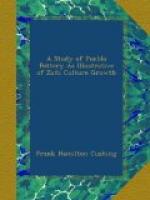The archaic name for a building or walled inclosure is he sho ta, a contraction of the now obsolete term, he sho ta pon ne, from he sho, gum, or resin-like; sho tai e, leaned or placed together convergingly; and ta po an ne, a roof of wood or a roof supported by wood.
[Illustration: FIG. 491.—Perspective view of earliest or Round-house structure of lava.]
The meaning of all this would be obscure did not the oldest remains of the Pueblos occur in the almost inaccessible lava wastes bordering the southwestern deserts and intersecting them and were not the houses of these ruins built on the plan of shelters, round (see Figs. 491, 492, 493), rather than rectangular. Furthermore, not only does the lava-rock of which their walls have been rudely constructed resemble natural asphaltum (he sho) and possess a cleavage exactly like that of pinon-gum and allied substances (also he sho), but some forms of lava are actually known as a he sho or gum-rock. From these considerations inferring that the name he sho ta pon ne derivatively signifies something like “a gum-rock shelter with roof supports of wood,” we may also infer that the Pueblos on their coming into the desert regions dispossessed earlier inhabitants or that they chose the lava-wastes the better to secure themselves from invasion; moreover that the oldest form of building known to them was therefore an inclosure of lava-stones, whence the application of the contraction he sho ta, and its restriction to mean a walled inclosure.
[Illustration: FIG. 492.—Plan of Pueblo structure of lava.]
[Illustration: FIG. 493.—Section of Pueblo structure of lava.]
RECTANGULAR FORMS DEVELOPED FROM CIRCULAR.
It may be well in this connection to cite a theory entertained by Mr. Victor Mindeleff, of the Bureau of Ethnology, whose wide experience among the southwestern ruins entitles his judgment to high consideration. In his opinion the rectangular form of architecture, which succeeds the type under discussion, must have been evolved from the circular form by the bringing together, within a limited area, of many houses. This would result in causing the wall of one circular structure to encroach upon that of another, suggesting the partition instead of the double wall. This partition would naturally be built straight as a twofold measure of economy. Supposing three such houses to be contiguous to a central one, each separated from the latter by a straight wall, it may be seen that (as in the accompanying plan) the three sides of a square are already formed, suggesting the parallelogramic as a convenient style of sequent architecture.
[Illustration: FIG. 494.—Evolution of rectangular forms in primitive architecture.]
All this, I need scarcely add, agrees not only with my own observations in the field but with the kind of linguistic research above recorded. It would also apparently explain the occurrence of the circular semisubterranean ki wi tsi we, or estufas. These being sacred have retained the pristine form long after the adoption of a modified type of structure for ordinary or secular purposes, according to the well known law of survival in ceremonial appurtenances.




